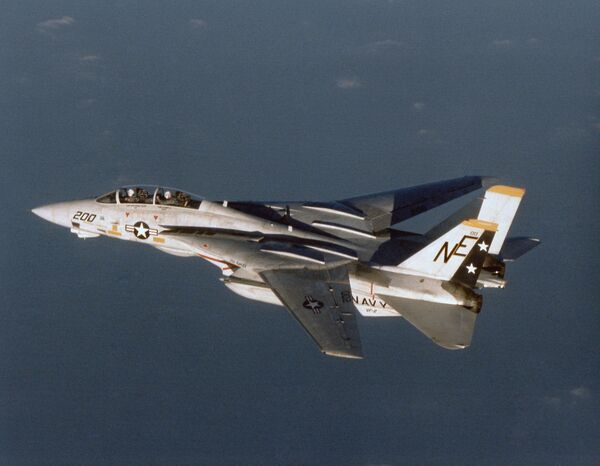Decades since Iran became the only country besides the United States to operate the Grumman F-14 Tomcat, a swing-wing carrier fighter embellished with a sophisticated radar and long-range AIM-54 Phoenix air-to-air missiles, Tehran has succeeded in maintaining its fleet of F-14s in fighting shape, writes The National Interest.
Iran’s 40 or so surviving F-14s took to the air in several conflicts and after the US Navy retired its last Tomcats in 2006, they remain the only active Tomcats left in the world.
Here are some of the cited reasons why the aged fleet is still to be reckoned with.
Variable Geometry Wings
The F-14 Tomcat’s variable geometry wings, that could be optimized for low speed and high-speed maneuvers, proved to be its ticket to enduring success.
In a feature key for landing on short aircraft carrier decks, the wings would be swept outwards during low-speed flight, providing higher amounts of lift, which was also boosted by the relatively wide fuselage and widely-spaced engines.
A more aerodynamic shape could be adopted by sweeping the Tomcat’s wings inwards at higher speeds, creating a lower-drag.
In cramped conditions of an aircraft carrier deck, the wings of the aircraft could be tucked in still further, allowing for more generous parking space for other aircraft.
Maneuverability
The American supersonic, twin-engine, two-seat, twin-tail, variable-sweep wing fighter aircraft F-14 Tomcat, developed for the United States Navy, boasted remarkable maneuverability and was easy to fly, recalled a former F-14 pilot.
Five years before the 1979 Islamic Revolution, Shah Mohammad Reza Pahlavi, himself a pilot, arranged for Iran to acquire from the United States 80 Grumman F-14A Tomcats and 633 Hughes AIM-54 Phoenix missiles for $2 billion, writes the outlet, thus becoming the only other country to fly the fighters.
At the time, Iranians also insisted on acquiring the entire weapon system, including aircraft, avionics, weapons and support infrastructure, which possibly explains why Tehran’s fleet of F-14s is still viable, besides getting mileage out of the aging planes by resorting to domestically-built or internationally-acquired parts, according to The National Interest.
120 pilots and radar intercept officers in the Iranian Imperial Air Force (IIAF) had been trained in the United States and Iran by 1979, with the pilots having no major difficulties in mastering the ability to maneuver the large fighters.
Former pilot Major Farhad was cited as recalling the airplane’s maneuverability:
“F-14s equipped with the AWG-9 pulse Doppler radar, the Iranian pilots could hit an enemy aircraft from 100 miles away, but the pilots also appreciated the airplane’s fighting abilities close in.”
The ex-pilot adds:
“The capability of the F-14A to snap around during the dogfight was unequalled… After only 100 hours of training, I learned to pitch the nose of my Tomcat up at a 75-degree [angle of attack] in just over a second, turn around, and acquire the opponent either with Sidewinders or the gun.”
The Tomcat was retired by US Navy on 22 September 2006, having been supplanted by the Boeing F/A-18E/F Super Hornet.
From 1981, Iranian Aircraft Industries undertook overhauls and upgrades on the F-14s as part of the military self-sufficiency programme. The fleet remains airworthy in no small measure due to massive efforts to maintain a flow of spare parts - whether by producing or acquiring them abroad, writes the outlet.
Iran had also reportedly upgraded the Tomcats with new radar components, radios, navigation systems and wiring while also adding compatibility with R-73 and Hawk missiles.
Iran’s F-14s have lost none of their importance to the Persian state’s defense, concludes the publication.



